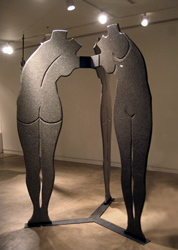Sculptural Roots
By D. Eric Bookhardt, GAMBIT WEEKLY
[Excerpt]
Where does art come from? Most artworks spring from an artist’s deeply personal responses to a world that is largely impersonal. Life is always a learning experience, but artists are often motivated to make art by a feeling that there is something they need to resolve, whether it’s unique to themselves or part of some broader issue. Either way, an artist is someone who puts his or her own stamp on the world by transforming experience into a personal mythology of some sort.
Sometimes experience is conditioned by external factors that we have no control over, such as race, ethnicity, nationality and the like.
. . . .
For Texas sculptor Jesus Moroles, it’s all about granite, a material that he regards as one of the most essential ingredients of life on earth. His work also harks to modernist as well as more anthropological influences, which he blends into a seemingly seamless amalgam. His current show reinforces some of the trends seen last time, namely more figurative pieces mingling with his traditional monumental geometry. And while there has always been a hint of something Aztec in Moroles’ vision, he may be a bit more eclectic in his references this time around.
 Broken Earth Wheel is a 15-inch red granite shaft on a black granite base. Sitting atop its gallery pedestal, it
Broken Earth Wheel is a 15-inch red granite shaft on a black granite base. Sitting atop its gallery pedestal, it recalls those Indian Hindu fertility symbols at first, but then you notice that the shaft has been incised with fissures reflecting Moroles’ view that the Earth is broken, in trouble. Surprisingly, it turns when you push it, rather like a Tibetan prayer wheel, which the artist claims as one of his inspirations for the piece. Tres Mujeres is very different, an arrangement of three flat, 10-foot-tall granite female figures seemingly swaying around a central axis, as if around an invisible Maypole. Here the tone is almost Matissean, with figuration reduced to suggestive lines, in a whimsical departure from his usual architectonic geometry. Even so, the show’s tone was set by the numerous Broken Earth works in which granite appears carved to resemble rock formations, eroded and precariously balanced, as if awaiting the latest tremor from Mt. St. Helens to set them crashing down in a rollicking rockslide. It’s a foreboding sensibility that gives these pieces their quiet drama, a portentous quality like the uncanny calm before a storm.
recalls those Indian Hindu fertility symbols at first, but then you notice that the shaft has been incised with fissures reflecting Moroles’ view that the Earth is broken, in trouble. Surprisingly, it turns when you push it, rather like a Tibetan prayer wheel, which the artist claims as one of his inspirations for the piece. Tres Mujeres is very different, an arrangement of three flat, 10-foot-tall granite female figures seemingly swaying around a central axis, as if around an invisible Maypole. Here the tone is almost Matissean, with figuration reduced to suggestive lines, in a whimsical departure from his usual architectonic geometry. Even so, the show’s tone was set by the numerous Broken Earth works in which granite appears carved to resemble rock formations, eroded and precariously balanced, as if awaiting the latest tremor from Mt. St. Helens to set them crashing down in a rollicking rockslide. It’s a foreboding sensibility that gives these pieces their quiet drama, a portentous quality like the uncanny calm before a storm.
WHAT: Jesus Moroles: Broken Earth
WHEN: Through Nov. 20
WHERE: Arthur Roger Gallery Project, 730 Tchoupitoulas St., 522-1999
